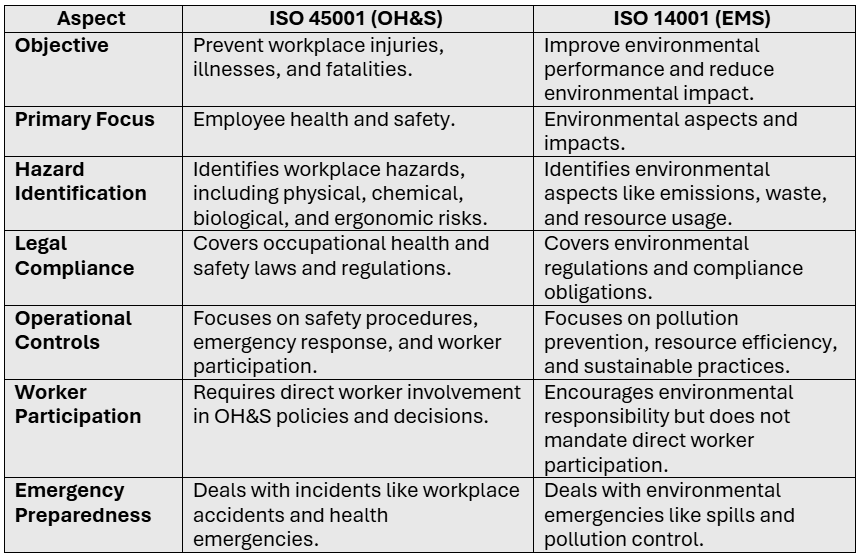Article
Key Differences and Similarities Between ISO 45001 and ISO 14001 Standards

Author
Sudha Kiran
Global Head of Marketing

In today’s evolving business landscape, organizations increasingly recognize the importance of integrating management systems to improve efficiency, compliance, and overall performance. Two widely adopted international standards that contribute to sustainable business operations are ISO 45001 (Occupational Health and Safety Management Systems) and ISO 14001 (Environmental Management Systems). Both standards share a common framework under the Annex SL structure but cater to distinct aspects of organizational responsibility.
This blog explores the key similarities and differences between ISO 45001 and ISO 14001, helping organizations implement and maintain an integrated management system effectively.
Understanding ISO 45001 and ISO 14001
- ISO 45001: This international standard focuses on occupational health and safety (OH&S) management. It aims to prevent work-related injuries and illnesses while promoting a safe and healthy work environment.
- ISO 14001: This standard is dedicated to environmental management, helping organizations enhance their environmental performance, reduce environmental impact, and comply with regulatory requirements.
Despite their unique objectives, both standards align closely in terms of structure and fundamental principles.
Similarities Between ISO 45001 and ISO 14001
- Annex SL High-Level Structure (HLS): Both standards follow the Annex SL framework, ensuring compatibility and ease of integration with other ISO management system standards.
- Risk-Based Thinking: ISO 45001 and ISO 14001 emphasize risk-based thinking and proactive measures to mitigate risks before they result in negative impacts.
- Leadership Commitment: Both require strong leadership commitment, ensuring that top management takes an active role in policy development, resource allocation, and continuous improvement.
- Continuous Improvement (PDCA Cycle): The Plan-Do-Check-Act (PDCA) cycle forms the foundation for both standards, driving continuous enhancement of system effectiveness.
- Compliance with Legal and Regulatory Requirements: Organizations implementing these standards must identify, assess, and comply with relevant legal obligations.
- Stakeholder Engagement and Communication: Both standards emphasize the importance of stakeholder involvement, internal and external communication, and transparent reporting mechanisms.
Key Differences Between ISO 45001 and ISO 14001

Implementing an Integrated Management System (IMS)
Organizations seeking to streamline their management systems can integrate ISO 45001 and ISO 14001 into a single, cohesive framework. Benefits of an Integrated Management System include:
- Reduced duplication of efforts and documentation
- Improved compliance with both OH&S and environmental regulations
- Enhanced organizational efficiency and effectiveness
- Better risk management and resource optimization
- A unified approach to internal audits, training, and continual improvement
By adopting an integrated approach, organizations can drive sustainable growth while ensuring employee safety and environmental responsibility.
Kelmac Group’s Combined ISO 45001 and ISO 14001 Training
For organizations aiming to implement, maintain, and improve an integrated OH&S and environmental management system, Kelmac Group offers comprehensive combined training on ISO 45001 and ISO 14001. Our expert-led training programs provide:
- A detailed understanding of both standards and their implementation requirements
- Practical insights on integrating OH&S and environmental management systems
- Guidance on risk assessment, compliance, and continual improvement
- Interactive learning experiences with real-world case studies
Our combined training helps professionals and organizations streamline their management systems, ensuring compliance and best practices for both occupational health and environmental management.
Conclusion
ISO 45001 and ISO 14001 play critical roles in fostering a safer workplace and a healthier planet. While each standard serves a unique purpose, their similarities make integration an effective approach for organizations committed to compliance and sustainability. By leveraging Kelmac Group’s specialized training, businesses can enhance their management systems, drive operational excellence, and create a culture of continuous improvement.
To learn more about our ISO 45001 and ISO 14001 Combined Training, visit Kelmac Group today!
Featured Articles
Mon, 17 Jul 2023
Scheme: Others
Kelmac Group® Academy introducing its first Webinar on Quality Management
Kelmac Group® Academy is excited to announce its first-ever webinar titled "Concepts on the Golden Triangle in the Context of a Quality Management System." This webinar, scheduled for August 9th, 2023, will delve into the intricacies of the Golden Triangle and its application within a QMS.
Learn MoreMon, 26 Jun 2023
Scheme: Food Safety
Understanding the Differences: ISO 22000 vs. FSSC 22000
In this blog post, we will explore what ISO 22000 and FSSC 22000 are, discuss their differences, and provide some guidance on choosing the right standard for your organization.
Learn MoreThu, 22 Jun 2023
Scheme: Medical Devices ISO 13485
Step-by-Step Guide to ISO 13485 Fundamental Training Course
In this blog, we will provide a step-by-step guide to help you navigate through an ISO 13485 fundamental training course.
Learn MoreWed, 21 Jun 2023
Scheme: Occupational Health & Safety
The Importance of ISO 45001 Lead Auditor Training in Achieving Workplace Safety Standards
This blog explores the significance of ISO 45001 Lead Auditor Training, the benefits it offers, and how organizations can obtain this valuable training through reputed training providers.
Learn MoreMon, 06 Feb 2023
Scheme: Quality Management
ISO 9000 QUALITY MANAGEMENT
ISO 9001 sets out the criteria for a quality management system and is the only standard in the family that can be certified to (although this is not a requirement).
Learn More